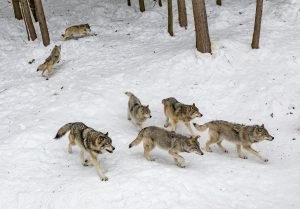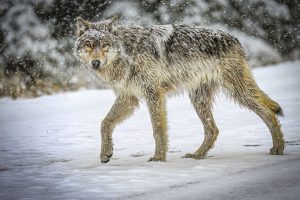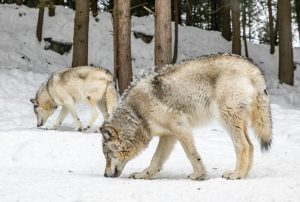
On February 29, 2024, a man by the name of Cody Roberts ran down a wolf with his snowmobile outside Daniel, Wyoming, a small town of 148 people in Sublette County, about 100 miles south of Yellowstone National Park. The wolf was wounded by the collision, but it didn’t die. Not right away. Roberts leashed the injured animal, muzzled it, and proceeded to torture it. Then he brought the wolf down to the Green River Bar in Daniel, parading it around for all of the establishment’s patrons to see. Some of those patrons captured the scene on video. In the footage, the captive animal lies on a beer-splattered wooden floor in the corner of the bar. Bar-goers chatter in the background, out of frame. Roberts, with a beer in his hand and a smile on his face, takes a knee and poses with the wolf. The wolf gives a weak, half-hearted growl before submitting to the man who has taken it prisoner. Roberts leans in and gives the wolf a kiss. Later that night, Cody Roberts took the wolf home and shot it in the head.
The footage went viral, sparking international outrage. Hashtags like #BoycottWyoming began trending on social media. Memes were made, including one depicting the Wyoming state flag with the words “WYOMING: THE ANIMAL ABUSE AND TORTURE STATE” overlaid in bright red font. Roberts received thousands of death threats from around the world.
A game warden from the Wyoming Game and Fish Department investigated the incident and charged Roberts with the illegal possession of wildlife, a misdemeanor offense carrying only a $250 fine. For torturing and killing the wolf, Roberts initially faced no legal consequences.
What Cody Roberts did to that wolf was “horrific,” says Kristin Combs, executive director of Wyoming Wildlife Advocates, a nonprofit organization and A2 member promoting modern, science-based wildlife management practices in Wyoming. Even more horrific was that what Cody Roberts did to that wolf was entirely legal under Wyoming law at the time—everything except possessing the wolf while it was still alive.
To understand how such cruel and unusual treatment of wildlife could possibly be legal in the 21st century, it helps to zoom out and consider the state of Wyoming in its entirety.

A pack of wolves in the snow. Photo Credit: Eva Blue, Unsplash
Wyoming is home to at least 352 gray wolves, according to the latest report from the Wyoming Game and Fish Department. Of those wolves, 124 live in Yellowstone National Park, which spans 2.2 million acres in the northwestern corner of the state. The hunting, trapping, and killing of wolves is strictly prohibited within Yellowstone’s boundaries. Had Roberts acted within Yellowstone, he would have faced federal charges including up to 6 months in prison, at least $10,000 in fines, and loss of hunting privileges nationwide.
Bordering Yellowstone to the south and east is Wyoming’s Trophy Game Management Area (TGMA), home to another 192 documented gray wolves. In the TGMA, wolves are listed as “trophy game animals” under state law. Licensed, regulated hunting is permitted, but tags are limited. Hunting a wolf without a license in the TGMA can bring charges of up to one year in jail, a $10,000 fine, and mandatory restitution up to $10,000 per wolf.
Combined, Yellowstone and the TGMA make up about 15 percent of Wyoming. In the rest of the state, it’s a “free-for-all,” Combs says.
The Predatory Animal Management Area—otherwise known as the “predator zone”—makes up the remaining 85 percent of Wyoming. And in the predator zone, wolves are classified as, well, predators. No license is required to hunt, trap, or otherwise kill a wolf in Wyoming’s predator zone. There are no bag limits; folks can kill as many wolves as they please, by any means necessary. “You can shoot them at night with spotlights and night vision and infrared,” Kristin Combs says. “You can dynamite their dens if you want. There are no restrictions or regulations.” You can even run a wolf down with a snowmobile, as Cody Roberts did, so long as you kill it immediately. The only thing you can’t do to a wolf in the predator zone, it seems, is take possession of a live wolf, bring it down to the local bar, and promenade it around for all to see. Considering all of this, it comes as no surprise that Wyoming’s predator zone, an area of about 83,000 square miles, is home to only 24 documented gray wolves.
This archaic wolf management isn’t rooted in science, but an ideology held over from the Old West, Combs says: “When Westward Expansion happened, we cleansed the landscape for livestock. We had this very specific attitude that there is good wildlife and bad wildlife. Good wildlife are elk and deer, and bad wildlife are carnivores. That is still the pervasive attitude of Wyomingites. Things have not progressed here very much over the past 150 to 200 years.”
Prior to European settlement, an estimated 250,000 to two million wolves populated North America, with wolves abundant in what is now Wyoming. In the late 1800s and early 1900s, U.S. federal and territorial predator control programs aggressively targeted wolves to protect livestock. By the 1930s, wolves were effectively eradicated from Wyoming and most of the Lower 48.

A wolve walks through the snow. Photo Source: Photo source: Amy Fain Gerber, Cub Creek Photography.
Since then, efforts to reintroduce and protect wolves in Wyoming—such as the listing of gray wolves under the Endangered Species Act in 1978 and the reintroduction of wolves to Yellowstone National Park in 1995—have been met with hostility, particularly by the state’s hunters, farmers, and ranchers. Many hunters are anti-wolf because they fear that wolves might decimate the state’s deer and elk populations, resulting in fewer hunting tags for human beings. Many farmers and ranchers are anti-wolf because they fear that wolves might slaughter their livestock, threatening their livelihoods and way of life. As Kristin Combs puts it: “People still hate wolves very much here.”
Wolf management in Wyoming is stuck in the 19th century, Combs says. Wyoming Wildlife Advocates (WWA) is working to change that by educating the public about the keystone role that wolves play in the state’s ecosystems. “Wolves are not this evil, bloodthirsty, awful thing that’s out there,” says Combs, who holds a master’s degree in science education from Montana State University. “They are an important part of the ecosystem.”
The ecological benefits that wolves bring to the landscape have been well-documented in the scientific literature. As apex predators, wolves regulate deer and elk populations and alter their grazing patterns, reducing overgrazing and allowing willow, aspen, and cottonwood stands to regenerate. This vegetation recovery provides habitat for beavers to build dams and create wetlands, which creates habitat for numerous native species and builds resilience against wildfire and drought.
Moreover, as Kristin Combs points out, wolves don’t indiscriminately massacre entire herds of deer and elk, as some hunters fear they might. Wolves target weak, sick, and injured prey, which improves herd health and may help mitigate the spread of diseases like chronic wasting disease.

Two wolves in the snow. Photo Source: Eva Blue, Unsplash
It’s true that wolves sometimes prey on livestock, but wolf predation accounts for a small fraction of Wyoming’s livestock losses. In 2023, wolves killed 49 head of livestock in Wyoming—mostly cattle, sheep, and goats—representing a fraction of a percent of the state’s total livestock numbers. “The number of ranchers that have actually been impacted by wolves is very, very small,” Combs says. “We’re not talking about a widespread, large-scale problem.”
What’s more, killing wolves often makes livestock depredation worse. When alpha wolves are killed, it disrupts pack dynamics, leaving inexperienced wolves that may turn to easier livestock targets instead of their native prey. Study after study has shown that killing wolves does little to prevent livestock losses long term. Nonetheless, this is how Wyoming continues to manage wolves in the predator zone: lethally. “We can’t kill our way out of this problem,” Combs says. “And that’s the thing that Wyoming is trying to do in perpetuity.”
Fortunately for wolves, humans, and livestock, there is another way to manage wolves that does prevent livestock losses: non-lethal wolf management.
“The number one thing that is most effective is having people on the landscape, range riders, with your livestock,” Combs says. “That alone diminishes the risk of wolf predation by almost 100 percent.”
Other non-lethal practices—like guardian dogs, electric fencing, and fladry (fencing with colored flags that flutter as visual warnings)—have proven highly effective in deterring wolves, especially when combined and maintained over time. One study, published in Global Ecology and Conservation in 2020, found these tools are between 50 and 100 percent effective at preventing livestock depredation. Simply put, “livestock and wolves don’t have to be mutually exclusive on the landscape,” Combs says. WWA is currently working to raise funding to distribute these non-lethal tools to local ranchers willing to implement them.
The organization also engages in legislative advocacy. In 2024, spurred by the Cody Roberts case, WWA launched its “Wyoming Draws the Line” campaign to advocate for legal reforms against animal cruelty and outdated predator management practices. The campaign proved influential in passing House Bill 275 (“Treatment of Animals”) in March 2025, which increased penalties for animal cruelty—even for species classified as predators.
Which brings us back to Cody Roberts. In late August of this year, following an 18-month investigation by the Sublette County Attorney’s Office, a grand jury indicted Roberts on felony animal cruelty charges. If convicted, Roberts could face up to two years in prison, pay a $5,000 fine, and lose his hunting and fishing privileges—a far steeper punishment than the $250 slap on the wrist that he initially received.
“We are pleased to see this grand jury indictment of Cody Roberts,” Kristin Combs wrote via email on August 26, a few days after the indictment. “This indictment has big implications for animals in Wyoming in that any animal can fall under the animal abuse statutes, no matter how they are classified. We look forward to seeing how this plays out and hope it is a deterrent for anyone else who thinks torturing animals is a part of ‘our Western way of life.’”

